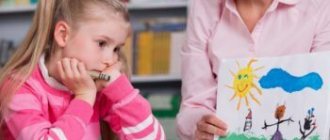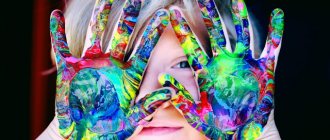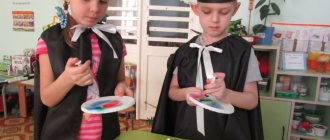MAGAZINE Preschooler.RF
“Development of creative abilities of children 4-5 years old through theatrical activities”Prepared by: Svetlana Valentinovna Malashchuk, teacher at MBDOU “Kindergarten No. 137” , Dzerzhinsk, Nizhny Novgorod region
“Theatrical activity is the most accessible activity for a child and an interesting way for him to process and express impressions, knowledge, and emotions.”
(A.V. Zaporozhets.)
Thanks to theatricalization, the child not only learns about the world, but also expresses his own attitude towards good and evil, and becomes familiar with folklore and national culture. Today, teachers are faced with the task of improving traditional methods of preschool education of children and finding new approaches to organizing the educational process. When observing children during play, a large gap is revealed between interests, plans and their implementation. The characteristic features of theatrical games are the literary or folklore basis of their content and the presence of spectators. They can be divided into two main groups: dramatizations and directorial ones (each of them, in turn, is divided into several types). In dramatization games, the child, playing a role as an “artist,” independently creates an image using a set of means of verbal and nonverbal expressiveness. Types of dramatization are games that imitate images of animals, people, and literary characters; role-playing dialogues based on text; staging of works; staging performances based on one or more works; improvisation games with the acting out of a plot (or several plots) without prior preparation. In director's play, the “artists” are toys or their substitutes, and the child, organizing the activity as a “scriptwriter and director,” controls the “artists.” The types of director's games are determined in accordance with the variety of theaters used in kindergarten: tabletop, flat and three-dimensional, puppet (bibabo, finger, puppets), etc. In kindergarten, children's theatrical play activities take two forms: object-based games, when the characters are certain objects (toys, dolls, figures, bibabo dolls, tabletop and puppet theater, etc.), or director's games and non-objective games, when children They themselves, in the image of the character, perform the role they have taken upon themselves; the children themselves are in the image of the character—the dramatization game. It is the plot-role-playing game that is a kind of springboard on which theatrical play receives its further development.
During joint games with an adult, the child hears many new words, more complex phrases, expressions, and game situations become clear to him. While playing with a toy, the child comes up with and pronounces the situation of the game, uses new words.
In theatrical play, children get acquainted with feelings, master methods of emotional expression, self-realization, self-expression, get acquainted with the world around them through images, colors, sounds, which contribute to the development of mental processes, qualities and personality traits - imagination, independence, initiative, emotional responsiveness. Thus, theater in preschool practice is able to solve a number of important problems, such as: the formation of aesthetic taste; moral education; art education and parenting; development of personal communicative qualities (training in verbal and non-verbal types of communication); development of memory, imagination, initiative, fantasy, speech (monological and dialogical); creating a positive emotional mood, relieving tension; resolving conflict situations through play.
Theatrical activities in educational activities are game techniques and surprise moments. Fairy-tale characters help children better master knowledge, skills and abilities.
In the joint free activity of children and adults, the greatest impression on children is made by performances performed by adults and older children. Holidays and entertainment make a great impression on children. Independent children's games reflect characters and plots that excite children. Walking provides great opportunities for children's playful development. Children are given freedom of movement, space to play, and the opportunity to use paraphernalia and costume elements. If you use folklore material in your work, the emotional expression of children is stimulated and coherent speech develops. Already from the first games, children learn to create an elementary subject-spatial environment: prepare the necessary play material, take direct part, within their power, in arranging the place for play.
N. Karpinskaya developed a methodology for working with children on theatrical activities in the classroom.
When organizing dramatization games, great importance is attached to preliminary work, which begins with a lesson on familiarization with fiction. Children love having fairy tales read to them. In the course of a thorough acquaintance with the fairy tale, expressive reading should be combined with playing out individual episodes. Therefore, it is important to find the necessary means of expression: intonation, facial expressions, gestures. To do this, you can use the method of observing the habits of animals, imitate their movements together with children, and convey various states with your voice (fear, joy, surprise, affection). In the middle group, the prototype of theatrical games are games with a role. In addition, role-playing games activate and develop children’s imagination, preparing them for independent creative play. For this purpose, I conducted role-playing games: “The Mother Hen and the Chicks , “The Hare and the Little Hares,” and others. During the classes, we acted out small scenes from children’s everyday life, organized games based on literary works: “Toys” by A. Barto, “The Cat and the Goat” by V. Zhukovsky, etc.
To enrich the children's gaming experience, I carried out preliminary work: attending theatrical performances in preschool educational institutions; examination of toys, plot pictures and illustrations for fairy tales; complexes of thematic morning gymnastics - “Hike in the forest” , “Trained dogs” , “Butterflies” , “Zoo” , “Visiting the Christmas tree” ; learning dance moves and singing children's songs; use of coloring books and cut-out pictures based on fairy tales; retelling fairy tales by children, based on mnemonic tables and characters from tabletop and magnetic theater; dressing up in costumes of fairy tale heroes for games - dramatizations; outdoor games for a walk “Hen and Chicks” , “The Little Gray Bunny is Sitting” , “By the Bear in the Forest” , “Shaggy Dog” , “Hares and the Wolf” , “Cat and Mice” ; learning folk games “Vanya Walks” , “Bunny, Dance” , “Spider” ; round dance games “On a level path” , “The bunny walked” , “Inflate, bubble” , “In an even circle” ; learning finger games: “Turnip” , “We want to build a house” , “The deer has a big house” , “Alenka-little” ; conversations with children about safety at home and on the street using the characters and plots of these fairy tales. And when working with children, I used sketches and exercises that developed mental processes in children (attention, memory, perception, thinking, imagination): to develop attention and memory: “Who came first” , “Name your neighbor” ; to develop imagination: “Suppose that...” (For example, it started to rain, a strong wind was blowing, it became very cold), “Walk in the forest” (step over puddles, jump over a ravine, crawl under fallen trees, smell flowers, etc. .); on the accuracy and expressiveness of movements and gestures: “Forest animals” (how a bear, a wolf, a fox walks, a hare jumps, a hedgehog curled up in a ball), “Guess who I am, what I’m doing” (name the character based on the movements performed, for example: the doctor listens sick, pussy lapping up milk); on the expression of basic emotions: “The Fox and the Hare” (the fox is cunning, sometimes kind, the hare is fast, cowardly); “The she-bear and the cubs” (the cubs are hungry and ask for food - they ask affectionately, whine, angrily demand and even order); “A bear in a den” (The sun warmed up. The snow began to melt and water got into the bear’s den.). Sketches help children develop their creativity. I invited the children to depict individual episodes from their favorite fairy tales. For example: show how the Fox threw the fish out of the cart; how the Wolf caught a fish and said sentences; how the Fox built an ice hut, and the Hare built a bast hut. Thanks to such playful improvisations, the child gradually develops creative abilities, without which theatrical play is devoid of color and expressiveness.
To motivate the children, I used a question-and-answer form of communication based on the plot of the work. For example: “Who is the main character of V. Suteev’s fairy tale “Yolka?” , “Why did the tower break?” , “Who did Kolobok meet on his way?” etc. She also included in her work with children listening to sound recordings: children's fairy tales: “Masha and the Bear” , “The Wolf and the Seven Little Goats” , “Kolobok” , “Turnip” , Teremok” , Hen Ryaba” , “Cat, Rooster” and the Fox” , “Three Bears” , “Zayushkina’s Hut” , “Geese-Swans” , “Fear Has Big Eyes”, etc.
During routine moments (feeding, dressing, washing, getting ready for bed), I use nursery rhymes, jokes, and poems that help establish emotional contact between me and the child. To consolidate the acquired knowledge, I offer children game situations. For example: I bring a doll whose hands and face are dirty. I explain to the children that the doll Masha was walking on the street, stumbled and fell into the mud. We need to help her, but how? The children suggest that the doll needs to be washed. I suggest they wash Masha themselves. I distribute the actions between them: Vanya will pour water into the basin, Dasha will roll up the doll’s sleeves, etc. Seeing that interest in the game does not wane, I suggest giving the doll some tea. Children continue playing with the doll. An imperceptible change in the situation makes the game long and interesting. By using toys depicting living creatures in such situations, I try to instill in children empathy for those in trouble, a desire to help, and compassion. In order to instill in children’s minds ideas about positive and negative behavior, I conduct dramatization games in which I use elements of theatricality and show children situations characteristic of their age. In these situations, kids help toys with their advice. For example: I bring into the group the bunny Koska, who is crying bitterly, and the bear cub Toptyshka. The little bear offended the bunny and pushed him. The children, one by one and all together, explain to the bear how bad it is to push. Toptyshka asks the bunny for forgiveness.
Music, drawing and theater are so closely interrelated that it is sometimes difficult to determine the dominant activity. For example, you can use the technique of scoring when kids, learning songs, perform them on behalf of a character in a finger or glove theater. Or a toy - a song character - comes to visit to listen to the children sing about him. As part of a lesson in the middle group on the topic “Pets”, theatrical activity in the form of a mask theater. During the “Vegetables from the Garden” , you can use elements of theater on magnets from the fairy tale “Puff” : beds with cabbage, beets, carrots, and yellow turnips. Children can come to a drawing lesson, for example: “The Queen is a Brush” , show drawing techniques while telling an amazing fairy tale. You can make animal figurines from natural materials and act out a fragment from a familiar fairy tale with them, and you can also use a finger or table theater, for example, when acting out a plot about how a bear, wolf, squirrel, titmouse are looking for their houses. A special place is occupied by the use of theatricalization at holidays and entertainment. By participating in theatrical games, children get acquainted with the world around them through images, colors, and sounds. “secrecy” technique . In secret from other children, rehearse dramatizations, individual dances, poems. Parents should also be involved in this “secrecy” . If theater in the classical version begins with a hanger, then in kindergarten it begins with attributes. Our group room is equipped with a theater corner: all the dolls are placed in a place accessible to children, various types of theaters and masks are laid out; table screens of various themes and screens according to the height of children were made, various costumes were purchased and attributes for fairy tales were made. When building a development environment, special attention is paid to observing the principle of integration and flexible zoning. I try to involve children in the creative process by writing short fairy tales and stories: “Meeting in the Forest” , “The Bear and the Fox” , “If I Were a Wizard” . To develop imagination, I use the didactic exercise “Think of what happened next” ; To activate the thought process, we guess riddles based on fairy tales. As a result of this work, the children develop stability of interests. When showing fairy tales to children, I used various types of theaters that are available in my group: finger theater, on sticks, table theater, picture theater, on flannelgraph, magnetic theater, cone theater, bibabo. Already in the second half of the year, in the dramatization game, I tried to teach children to combine movement and words in roles, to use pantomime. I used educational exercises, for example: “Imagine yourself as a little bunny (fox, bear cub, wolf cub, etc.) and tell us about yourself .
Working on the intonation expressiveness of speech, she suggested singing the goat’s song from the fairy tale “The Wolf and the Seven Little Goats” either on behalf of the Goat or on behalf of the Wolf; recite specially selected short poems, sometimes in surprise, sometimes mockingly. Say the phrases: “They tore off the bear’s paw” , “This is my grandmother” , “The kitten ran around the room”, etc. - so that each time, thanks to the change in the stressed word, the meaning of the entire phrase changes. I suggested that the child ask a friend for a toy: politely, demandingly, with resentment; ask questions on behalf of Mikhail Ivanovich, Nastasya Petrovna, Mishutka from the fairy tale “The Three Bears” by L.N. Tolstoy, so that the listeners can guess which of the bears is asking; conduct a dialogue between two children, where they ask each other questions on behalf of a hare, fox, bear, etc. To develop expressiveness of movements, I invited children to walk on pebbles across a stream on behalf of any character from a fairy tale they had read or a story of their choice; on behalf of any character, sneak up on a sleeping animal (hare, bear, wolf); depict a walk of a family of three bears. She also developed game tasks and situations that promote the creative expression of preschoolers. For example: “The fox is eavesdropping” (The fox stands at the window of the hut in which the Cat and the Cockerel live, and overhears what they are talking about); “Catching butterflies” (sneak up, extend your arms, cover with your palms); “After the rain” (walk carefully without getting your feet wet, or jump in puddles so that the splashes fly in different directions); “Guess who I am” (the child uses gestures, facial expressions, sounds and movements to depict someone or something, and the rest of the children guess). And you can also congratulate the doll Masha, cheer up the sad Mishutka, and help Karkusha. Working Such games develop children's creative abilities. Before starting work on dramatizing fairy tales, I and a group of the most active children tried to show the simplest fairy tales using a tabletop theater: “Teremok” , “Zayushkina’s Hut” , “The Three Bears” , “The Three Little Pigs” . With low-active children, I dramatized works in which there is a small number of actions, for example: “Kittenka - Murysenka” , “Sunshine and Rain” , “Two Cheerful Geese” , “Sunshine is a Bucket” , Little Bunny is a Coward” , “A Fox Is Walking Across the Bridge” etc. With these nursery rhymes, I invited the children of my group to perform in front of each other, using the plot-role-playing game “Theater” . The children began to listen to fairy tales with great interest, imitate the movements of animals, pronounce onomatopoeia, dress up in skirts, aprons, scarves, caps, hats from the theater corner, use these outfits in independent activities in the play corner, in role-playing games, when dramatizing episodes from favorite fairy tales. In addition, I introduce children to theater professions. Children have a basic understanding of what actors, make-up artists, directors, costume designers, and lighting technicians do. We involve parents in preparing and holding holidays, entertainment, and games. Conducted consultations for parents on the topic: “The role of play in the family” ; “The role of theatrical activities in the development of a child’s creative abilities” ; "Education with a fairy tale" . She developed and conducted a survey on the topic: “Theater and Children ,” the purpose of which was to identify the degree of interest of parents in the development of children’s creative abilities through theatrical activities and to determine the further direction of work with children on this topic.
It is theatrical activities that make it possible to solve many pedagogical problems related to the formation of the expressiveness of a child’s speech, intellectual and artistic-aesthetic education. By participating in theatrical games, children experience various events from the lives of people, animals, and plants, which gives them the opportunity to better understand the world around them.
| Next > |




